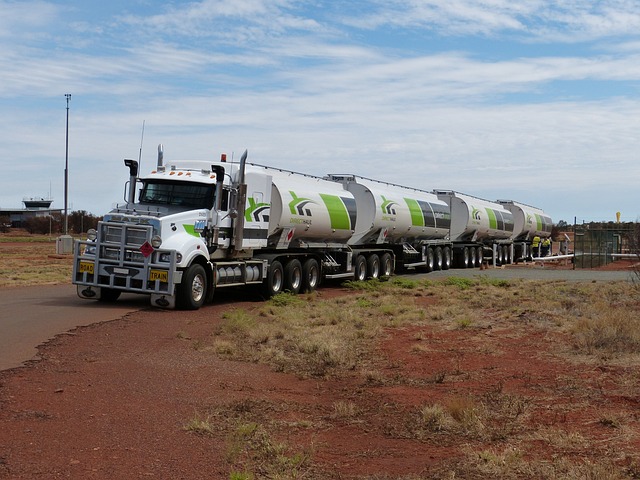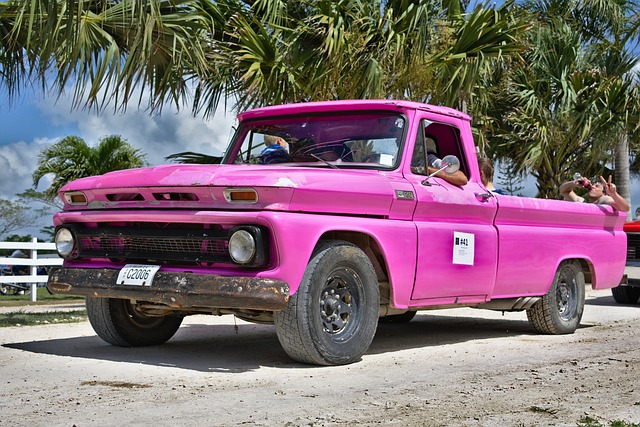During winter operations, truck batteries require special attention due to the environmental stressors that can impair their performance and longevity. The cold slows down chemical reactions within lead-acid batteries, causing the electrolyte to thicken and reduce conductivity, which can make it difficult to start engines in freezing conditions. To mitigate this, fleet managers and truck owners should conduct regular maintenance checks, including terminal corrosion inspections and maintaining proper charging levels throughout the year. Opting for specialized truck batteries with high cold cranking amps (CCA) is crucial for ensuring reliable engine starts in cold weather. These batteries should also be built with robust materials resistant to temperature fluctuations and vibrations, and some may include advanced thermal management systems and heat sensors to maintain optimal temperatures. Additionally, protective covers and devices like battery warmers or engine block heaters can help maintain the battery's charge and functionality in sub-zero conditions. AGM (Absorbent Glass Mat) or lithium-ion truck batteries are recommended for their enhanced performance and durability in cold environments, making them essential for year-round reliability in heavy-duty vehicles operating under extreme cold conditions. Regular maintenance, including terminal cleaning and insulation, along with protective measures like battery warmers, ensures the truck battery operates effectively despite the challenges posed by winter temperatures.
When winter’s chill sets in, ensuring your truck’s battery remains reliable is paramount. This article delves into the science behind how cold weather affects truck batteries and outlines pivotal specifications for batteries operating under frosty conditions. From understanding the types of batteries that withstand subzero temperatures to grasping the significance of capacity and cranking amps for cold resistance, we’ll navigate the key factors. Additionally, we’ll explore advanced features in modern truck batteries designed for cold regions, and provide maintenance tips to extend your battery’s life in the cold. With the right knowledge and choices, your truck battery can maintain peak performance even when the mercury dips.
- Understanding Cold Weather Impact on Truck Batteries
- Key Specifications to Consider for Cold Climate Truck Batteries
- Types of Truck Batteries Suitable for Cold Weather Conditions
- Capacity and Cranking Amps: The Essential Measures for Cold Resistance
- Advanced Features in Modern Truck Batteries for Cold Regions
- Maintenance Tips to Prolong the Life of Your Truck Battery in Cold Weather
Understanding Cold Weather Impact on Truck Batteries

When operating in cold weather conditions, truck batteries face unique challenges that can impact their performance and longevity. The chemical reactions within a lead-acid truck battery, which are responsible for generating electrical energy, slow down significantly as temperatures drop. This is due to the fact that the electrolyte solution, which contains sulfuric acid and water, becomes more viscous and less conductive when it’s cold, leading to reduced efficiency in converting chemical energy into electrical energy. As a result, the battery may struggle to start the engine, especially on mornings with sub-freezing temperatures. To mitigate this issue, drivers should ensure that their truck batteries are well-maintained and in optimal condition throughout the year. This includes regular inspections for corrosion on terminals, keeping the battery clean and charged appropriately. Additionally, selecting a truck battery specifically designed to perform in cold weather environments can provide an extra edge against the cold. These batteries often have a higher capacity to account for the reduced efficiency at lower temperatures, ensuring that they can still deliver the necessary power to start and run the vehicle’s systems reliably even when the mercury dips. Understanding this impact is crucial for fleet managers and truck owners to make informed decisions about their battery selection, ultimately ensuring the safety and reliability of their operations in diverse climates. It’s recommended to invest in a truck battery with a proven track record in cold weather regions, as these are built to handle the demands of such environments, providing uninterrupted service when it’s needed most.
Key Specifications to Consider for Cold Climate Truck Batteries

When selecting a truck battery for cold weather conditions, it’s crucial to focus on several key specifications that ensure optimal performance and longevity. Firstly, consider the battery’s cold cranking amps (CCA) rating. This figure indicates the amount of current the battery can supply at temperatures of 0°F (-18°C) for a minimum of 30 seconds without falling below a specified voltage. A higher CCA rating is essential for cold climates to ensure the engine starts reliably in freezing temperatures. Additionally, look for a battery with a high amp-hour (Ah) capacity. This measures how much energy the battery can store and supply over a period of time, which is critical for maintaining accessories and electronics when the truck is idle.
Another important specification is the reserve capacity (RC), which denotes the number of minutes a new, fully charged battery can deliver 25 amperes at 80°F (27°C) before its voltage drops to 1.2 volts per cell. In cold weather, an enhanced RC ensures that ancillary systems remain operational even when the engine is off. Furthermore, examine the battery’s construction and materials. A robust design with thicker plates and high-density active mass can improve performance in subzero conditions. Additionally, features like thermal runaway protection safeguard against excessive temperature rises, which can be a concern in extreme cold. Optimal battery maintenance, such as regular charging and checking electrolyte levels, is also vital to ensure the battery operates at peak efficiency regardless of the weather. By prioritizing these specifications, you can select a truck battery that’s well-equipped to handle the challenges of cold weather and keep your truck running smoothly in even the most adverse conditions.
Types of Truck Batteries Suitable for Cold Weather Conditions

When selecting a truck battery suitable for cold weather conditions, it’s crucial to understand the different types available and their abilities to perform under frosty temperatures. Truck batteries can generally be categorized into two main types: starting (cranking) batteries and deep-cycle batteries. Starting batteries, such as conventional lead-acid designs, are optimized for delivering high current for a short duration, which is essential for cranking the engine. In cold climates, these batteries must maintain enough energy to start the vehicle despite reduced chemical activity due to lower temperatures.
For environments where temperatures frequently dip below freezing, it’s recommended to opt for advanced AGM (Absorbent Glass Mat) or AGM-type truck batteries. These batteries are designed to withstand harsh conditions, offering improved performance and longevity. They feature a unique construction that resists vibrations and shocks common in heavy-duty trucks, ensuring consistent operation even when the mercury drops. Additionally, AGM batteries have a low self-discharge rate and can retain their charge in cold weather better than traditional lead-acid batteries. Another suitable option for cold weather is lithium-ion truck batteries, which provide exceptional power output, are more resistant to temperature fluctuations, and can maintain a stable voltage under extreme conditions. These attributes make them an ideal choice for ensuring your truck’s systems, including the starter and critical electronics, function reliably even when the weather outside is frightful.
Capacity and Cranking Amps: The Essential Measures for Cold Resistance

When faced with the harsh realities of cold weather, ensuring your truck’s battery can handle the frigid temperatures is paramount for dependable performance. Capacity and cranking amps are two critical measures that directly influence a truck battery’s ability to operate in subzero conditions. Firstly, capacity measures the amount of energy a battery can hold; this is crucial as more capacity typically means greater cold cranking amperes (CCA). CCA is a measure of the battery’s performance at a specific temperature, usually 0°F (-18°C), indicating how much current the battery can deliver for at least 30 seconds without falling below a certain voltage. For truck owners, especially those in regions with severe winters, selecting a battery with high CCA is essential to ensure the engine starts reliably even when it’s cold outside. The higher the CCA, the more power the battery has to turn over the engine at low temperatures.
In addition to high CCA, the physical construction of the battery also plays a role in its ability to function well in cold weather. Features like thicker plates and enhanced chemistry can improve a battery’s performance in extreme conditions. Additionally, batteries with built-in heaters or those enclosed in insulated cases can maintain optimal operating temperatures, further enhancing their reliability. Truck owners should look for AGM (Absorbent Glass Mat) or EFB (Enhanced Flooded Battery) types, as these are designed to handle the demands of cold environments better than traditional lead-acid batteries. By considering both capacity and cranking amps, along with the battery’s design and construction, truck owners can make an informed decision that ensures their vehicle starts every time, no matter how chilly it gets outside.
Advanced Features in Modern Truck Batteries for Cold Regions

When operating in cold weather regions, modern truck batteries must be equipped with advanced features to maintain optimal performance. These enhancements are crucial for ensuring that the battery can hold a charge and start the engine under frigid conditions. One such feature is the enhanced thermal management system, which helps regulate battery temperature, preventing it from becoming too hot or too cold, both of which can impair battery life and efficiency. This system often includes heat sensors that allow the battery to adjust its internal resistance for optimal charge acceptance, ensuring that the battery remains effective even when temperatures plummet.
Another key advancement in truck batteries designed for cold environments is the use of more robust materials for the electrodes and electrolyte solutions that do not solidify or freeze at low temperatures. These materials are chosen for their high specific energy and power density, allowing the battery to retain its energy storage capabilities in harsh conditions where traditional batteries might fail. Additionally, modern truck batteries may incorporate Absorbent Glass Mat (AGM) technology or advanced AGM variations that provide better protection against vibrations often encountered on rough terrain, further ensuring longevity and reliability even in the most demanding cold-weather applications. These features collectively contribute to the enhanced performance and durability of truck batteries in cold regions, making them indispensable for commercial transport and heavy-duty vehicles where consistent starting power is non-negotiable.
Maintenance Tips to Prolong the Life of Your Truck Battery in Cold Weather

When operating in cold weather conditions, the performance and longevity of your truck battery can be significantly impacted. To ensure your truck battery withstands the chill and remains reliable, it’s crucial to implement specific maintenance practices. Firstly, regularly check the battery’s charge level throughout the winter months. A fully charged battery is more resistant to the effects of cold temperatures. Additionally, clean the battery terminals and cables, removing any corrosion or buildup of grime, which can interrupt the connection and reduce efficiency. It’s also advisable to invest in a quality battery insulator or cover to protect the battery from extreme cold, as this can prevent the internal chemicals from freezing and becoming sluggish. Keeping the battery compartment clean and well-ventilated can further aid in maintaining an optimal temperature, preventing condensation that may form during temperature fluctuations and potentially damage the battery. Lastly, consider using a battery warmer or an engine block heater to gently maintain the battery’s charge and temperature, ensuring it operates at peak performance even when the mercury dips. Regular maintenance and proper protection measures are key to prolonging the life of your truck battery in cold weather conditions.
When operating trucks in cold weather environments, selecting the right truck battery is paramount for reliable starts and sustained performance. This article has outlined the critical factors to consider, from understanding how extreme temperatures affect battery function to exploring key specifications tailored for cold climates. By examining various types of truck batteries designed for such conditions and focusing on their capacity and cranking amps, you can ensure your vehicle’s battery remains resilient against the chill. Additionally, implementing maintenance tips can further extend your battery’s lifespan in these demanding circumstances. In essence, equipping your truck with a battery suited for cold weather is not just about safety; it’s an investment in dependable operation year-round.



